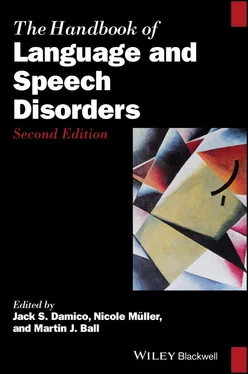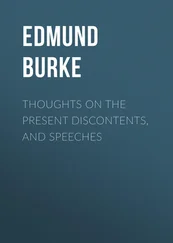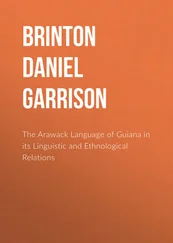7 Bishop, D. V. (1998). Development of the Children’s Communication Checklist (CCC): A method for assessing qualitative aspects of communication impairment in children. The Journal of Child Psychology and Psychiatry and Allied Disciplines, 39, 879–891.
8 Brock, J. (2007). Language abilities in Williams syndrome: A critical review. Development and Psychopathology, 19, 97–127.
9 Cardoso‐Martins, C., Mervis, C. B., & Mervis, C. A. (1985). Early vocabulary acquisition by children with Down syndrome. American Journal of Mental Deficiency, 90, 177–184.
10 Cashon, C. H., Ha, O. R., Estes, K. G., Saffran, J. R., & Mervis, C. B. (2016). Infants with Williams syndrome detect statistical regularities in continuous speech. Cognition, 154, 165–168.
11 Chapman, R. S. (2003). Language and communication in individuals with Down syndrome. In L. Abbeduto (Ed.), Language and communication in mental retardation (Vol. 27, pp. 1–34). Amsterdam, The Netherlands: Elsevier.
12 Chapman, R. (2006). Language learning in Down syndrome: The speech and language profile compared to adolescents with cognitive impairment of unknown origin. Down’s Syndrome, Research and Practice, 10(2), 61–66.
13 Chapman, R. S., & Hesketh, L. J. (2000). Behavioural phenotype of individuals with Down syndrome. Mental Retardation and Developmental Disabilities Research Reviews, 6, 84–95.
14 Chapman, R. S., Schwartz, S. E., & Kay‐Raining Bird, E. (1991). Language skills of children and adolescents with Down syndrome; I. Comprehension. Journal of Speech, Language and Hearing Research, 34, 1106–1120.
15 Clahsen, H., & Almazan, M. (1998). Syntax and morphology in Williams syndrome. Cognition, 68, 167–198.
16 Clahsen, H., & Almazan, M. (2001). Compounding and inflection in language impairment: Evidence from Williams syndrome (and SLI). Lingua, 111, 729–758.
17 Clahsen, H., Ring, M., & Temple, C. (2004). Lexical and morphological skills in English‐speaking children with Williams syndrome. In S. Bartke & J. Siegmüller (Eds.), Williams syndrome across languages (pp. 221–244). Amsterdam, the Netherlands: John Benjamins.
18 Clahsen, H., & Temple, C. (2003). Words and rules in children with Williams syndrome. In Y. Levy & J. Schaeffer (Eds.), Language competence across populations (pp. 323–353). Mahwah, NJ: Erlbaum Press.
19 Conway, C. M., Bauernschmidt, A., Huang, S. S., & Pisoni, D. B. (2010). Implicit statistical learning in language processing: Word predictability is the key. Cognition, 114, 356–371.
20 Cuskelly, M., Povey, J., & Jobling, A. (2016). Trajectories of development of receptive vocabulary in individuals with Down syndrome. Journal of Policy and Practice in Intellectual Disabilities, 13, 111–119.
21 Davies, M., Udwin, O., & Howlin, O. (1998). Adults with Williams syndrome. Preliminary study of social, emotional and behavioural difficulties. British Journal of Psychiatry, 172, 273–276.
22 Eadie, P. A., Fey, M. E., Douglas, M. E., & Parsons, C. L. (2002). Profiles of grammatical morphology and sentence imitation in children with specific impairment and Down syndrome. Journal of Speech, Language, and Hearing Research, 45, 720–732.
23 Epstein, C. J. (1986). The consequences of chromosome imbalance. New York, NY: Cambridge University Press.
24 Fodor, J. A. (1983). The modularity of mind. Cambridge, MA: MIT Press.
25 Fowler, A., Gelman, R., & Gleitman, L. (1994). The course of language learning in children with Down syndrome. In H. Tager‐Flusberg (Ed.), Constraints on language acquisition: Studies of atypical children (pp. 91–140). Hillsdale, NJ: LEA.
26 Franco, F., & Wishart, J. G. (1995). Use of pointing and other gestures by young children with Down syndrome. American Journal on Mental Retardation, 100, 160–182.
27 Gonçalves, Ó. F., Pinheiro, A. P., Sampaio, A., Sousa, N., Férnandez, M., & Henriques, M. (2010). The narrative profile in Williams syndrome: There is more to storytelling than just telling a story. British Journal of Development Disabilities, 56(111), 89–109.
28 Greenberg, F. (1990). Introduction. American Journal of Medical Genetics, 6(suppl), 85–88.
29 Helland, W. A., Biringer, E., Helland, T., & Heimann, M. (2009). The usability of a Norwegian adaptation of the Children’s Communication Checklist second edition (CCC‐2) in differentiating between language impaired and non‐language impaired 6‐to 12‐year‐olds. Scandinavian Journal of Psychology, 50(3), 287–292.
30 Howlin, P., Elison, S., Udwin, O., & Stinton, C. (2010). Cognitive, linguistic and adaptive functioning in Williams syndrome: Trajectories from early to middle adulthood. Journal of Applied Research in Intellectual Disabilities, 23(4), 322–336.
31 Jarrold, C., Baddeley, A. D., & Hewes, A. K. (1998). Verbal and non‐verbal abilities in the Williams syndrome phenotype: Evidence for diverging developmental trajectories. Journal of Child Psychology & Psychiatry, 39(4), 511–523.
32 Jarrold, C., Baddeley, A., & Phillips (2002). Verbal short‐term memory deficits in Down syndrome: A problem of memory, audition or speech? Journal of Speech, Language, and Hearing Research, 45, 531–544.
33 Joffe, V. L., & Varlokosta, S. (2007). Patterns of syntactic development in children with Williams syndrome and Down syndrome: Evidence from passives and Wh‐questions. Clinical Linguistics & Phonetics, 21(9), 705–727.
34 John, A. E., Dobson, L. A., Thomas, L., & Mervis, C. B. (2012). Pragmatic abilities of children with Williams syndrome: A longitudinal examination. Frontiers in Psychology, 3, 199.
35 John, A. E., & Mervis, C. B. (2010). Comprehension of the communicative intent behind pointing and gazing gestures by young children with Williams syndrome or Down syndrome. Journal of Speech, Language, and Hearing Research, 53(4), 950–960.
36 John, A. E., Rowe, M. L., & Mervis, C. B. (2009). Referential communication skills of children with Williams syndrome: Understanding when messages are not adequate. American Journal of Intellectual Developmental Disabilities, 114, 85–99.
37 Jones, W., Bellugi, U., Lai, Z., Chiles, M., Reilly, J., Lincoln, A., & Adophs, R. (2000). Hypersociability in Williams syndrome. Journal of Cognitive Neuroscience, 12, 30–46.
38 Karmiloff‐Smith, A. (1994). Beyond modularity: A developmental perspective on cognitive science. Cambridge, MA: MIT Press.
39 Karmiloff‐Smith, A. (1998). Development itself is the key to understanding developmental disorders. Trends in Cognitive Science, 2(10), 389–398.
40 Karmiloff‐Smith, A., Brown, J. H., Grice, S., & Peterson, S. (2003). Dethroning the myth: Cognitive dissociations and innate modularity in Williams syndrome. Developmental Neuropsychology, 23, 227–242.
41 Karmiloff‐Smith, A., Tyler, L. K., Voice, K., Sims, K., Udwin, O., Howlin, P., & Davies, M. (1998). Linguistic dissociations in Williams syndrome: Evaluating receptive syntax in on‐line and off‐line tasks. Neuropsychologia, 36, 343–351.
42 Kasari, C., & Baunminger, N. (1998). Social and emotional development in children with mental retardation. In J. A. Burack, R. M. Hodapp, & E. Ziegler (Eds.), Handbook of mental retardation and development (pp. 411–433). New York, NY: Cambridge University Press.
43 Lacroix, A., Bernicot, J., & Reilly, J. (2007). Narration and collaborative conversation in French‐speaking children with Williams syndrome. Journal of Neurolinguistics, 20(6), 445–461.
44 Laws, G., & Bishop, D. (2003). A comparison of language abilities in adolescents with Down syndrome and children with specific language impairment. Journal of Speech, Language, and Hearing Research, 46, 1324–1339.
45 Laws, G., & Bishop, D. (2004). Pragmatic language impairment and social deficits in Williams syndrome: A comparison with Down’s syndrome and specific language impairment. International Journal of Language and Communication Disorders, 39(1), 45–64.
Читать дальше












